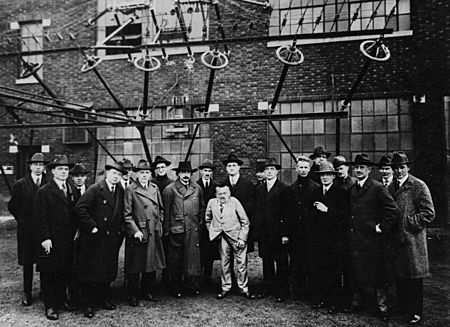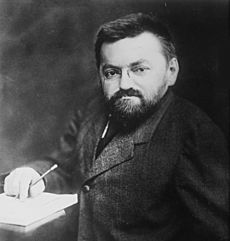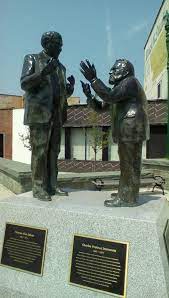Charles Proteus Steinmetz facts for kids
Quick facts for kids
Charles Proteus Steinmetz
|
|
|---|---|
 |
|
| Born |
Karl August Rudolph Steinmetz
April 9, 1865 |
| Died | October 26, 1923 (aged 58) Schenectady, New York, United States
|
| Resting place | Vale Cemetery |
| Occupation | Mathematician and electrical engineer |
| Known for |
|
| Awards | Elliott Cresson Medal (1913) Cedergren Medal (1914) |
Charles Proteus Steinmetz (born Karl August Rudolph Steinmetz, April 9, 1865 – October 26, 1923) was a brilliant German-born American mathematician and electrical engineer. He was also a professor at Union College. Steinmetz played a huge role in developing alternating current (AC) electricity. His work made it possible for the electric power industry to grow across the United States.
He created important mathematical ideas for engineers. He also made amazing discoveries about hysteresis, which helped engineers design better electric machines. This was especially true for electric motors used in factories. By the time he died, Steinmetz had over 200 patents. People called him "Forger of Thunderbolts" and "The Wizard of Schenectady" because of his genius. Many things are named after him, like Steinmetz's equation, Steinmetz solids, and the IEEE Charles Proteus Steinmetz Award.
Contents
Early Life and Education
Charles Proteus Steinmetz was born Karl August Rudolph Steinmetz on April 9, 1865. His birthplace was Breslau, Prussia (now Wrocław, Poland). His parents were Caroline (Neubert) and Karl Heinrich Steinmetz. He was baptized as a Lutheran.
Steinmetz was about 4 feet tall as an adult. He had dwarfism, a hunchback, and hip dysplasia. His father and grandfather also had these conditions. Steinmetz went to Johannes Gymnasium. His teachers were amazed by how good he was at mathematics and physics.
After Gymnasium, Steinmetz started college at the University of Breslau in 1883. He was close to finishing his doctorate degree in 1888. However, the German police started investigating him. This was because of his activities with a university group that had socialist ideas. He also wrote articles for a local newspaper that supported these ideas.
Moving to America
Because socialist meetings and newspapers were banned in Germany, Steinmetz left for Zürich in 1889. He wanted to avoid being arrested. Some historians say he also left because he owed tuition money and had family tension.
His visa for Zürich was about to expire, so he moved to the United States in 1889. He changed his first name to "Charles" to sound more American. He chose the middle name "Proteus" after a wise, hunchbacked character from the Odyssey. His classmates had given him this nickname as a child, and he felt it suited him.
Even though he was interested in socialist ideas earlier, Steinmetz later decided they wouldn't work in the U.S. He believed America needed a strong, central government with skilled leaders. He also felt that only a few Americans shared his views.
Steinmetz believed that machines could make life easier and create plenty for everyone. He once said, "Some day we [will] make the good things of life for everybody."
Contributions to Electrical Engineering
Steinmetz is famous for his work in three main areas of alternating current (AC) systems: hysteresis, steady-state analysis, and transients.
AC Hysteresis Theory
Soon after arriving in the U.S., Steinmetz started working for Rudolf Eickemeyer in Yonkers, New York. He published important work on magnetic hysteresis. This earned him recognition around the world. Eickemeyer's company made transformers for sending electrical power.
In 1893, the new General Electric Company bought Eickemeyer's company. This included all its patents and designs. Steinmetz quickly became known as a brilliant engineer at General Electric.
AC Circuit Theory
Steinmetz's work completely changed how AC circuits were understood and analyzed. Before him, engineers used complicated calculus methods that took a long time. In a key paper from 1893, Steinmetz made these methods much simpler. He turned them into "a simple problem of algebra."
He taught engineers to use complex numbers and phasors in electrical engineering. He used the letter "j" to show a 90-degree rotation in AC systems. His important books and papers taught many engineers how to work with AC electricity.
AC Transient Theory
Steinmetz also greatly improved our understanding of lightning. He did many experiments that led to the first "man-made lightning" in a lab. This earned him the nickname "Forger of Thunderbolts." He did these experiments in a huge lab at General Electric. He used generators that could produce 120,000 volts. He also built a lightning tower to attract natural lightning. This helped him study its patterns and effects, leading to new theories.
Professional Life and Honors
Steinmetz held many important professional roles:
- He was the head of electrical engineering at Union College from 1902 to 1913. He stayed on the faculty until his death in 1923.
- He served on the Schenectady Board of Education for six years. He was president of the board for four of those years.
- He was president of the Common Council of Schenectady.
- He was President of the American Institute of Electrical Engineers from 1901 to 1902.
- He was the first vice-president of the International Association of Municipal Electricians (IAME) from 1913 until his death. This group later became the International Municipal Signal Association (IMSA).
He received an honorary degree from Harvard University in 1901. Union College gave him a doctorate degree in 1903.
Steinmetz wrote 13 books and 60 articles. Not all of them were about engineering. He was a member and advisor to the fraternity Phi Gamma Delta at Union College. Their chapter house was one of the first homes to have electricity.
While leading the Schenectady Board of Education, Steinmetz made many modern changes. These included longer school hours, school meals, school nurses, and special classes for immigrant children. He also made sure free textbooks were given out.
Personal Life
Steinmetz had kyphosis, just like his father and grandfather. He loved children and wanted a family. However, he never married. He wanted to prevent his spinal condition from being passed on to any children.
His loyal lab assistant, Joseph LeRoy Hayden, decided to get married and move out. Steinmetz made an unusual offer. He invited the Haydens and their future family to live in his large home. His home had a research lab, a greenhouse, and an office. Joseph liked the idea, but his future wife was unsure. She agreed after Steinmetz promised she could manage the house as she wished.
After a difficult start, the arrangement worked well for everyone. This was especially true after the three Hayden children were born. Steinmetz legally adopted Joseph Hayden as his son. He became a grandfather to the children. He entertained them with amazing stories and cool science demonstrations. This unique and happy living arrangement lasted for the rest of Steinmetz's life.
Steinmetz started America's first glider club. However, none of their early designs could actually fly.
Steinmetz was an agnostic throughout his life. He died on October 26, 1923. He was buried in Vale Cemetery in Schenectady, New York.
Legacy and Recognition

Steinmetz was widely recognized by scientists. He received many awards and honors during his life and after his death.
Steinmetz's equation comes from his experiments. It helps calculate the heat energy lost due to magnetic hysteresis in materials. A Steinmetz solid is a 3D shape formed when two or three cylinders of the same size cross each other at right angles. The Steinmetz equivalent circuit is still used today to design and test induction machines.
The "IEEE Charles Proteus Steinmetz Award" is one of the highest honors given by the Institute of Electrical and Electronics Engineers. It recognizes major contributions to setting standards in electrical and electronics engineering. Other awards he received include the Certificate of Merit in 1908, the Elliott Cresson Medal in 1913, and the Cedergren Medal in 1914.
The Charles P. Steinmetz Memorial Lecture series began in his honor in 1925. It is sponsored by the Schenectady branch of the IEEE. These lectures are usually held at Union College. Famous speakers have included Nobel laureate physicist Robert A. Millikan, helicopter inventor Igor Sikorsky, and nuclear submarine pioneer Admiral Hyman G. Rickover.
Union College also celebrates Steinmetz with the annual Steinmetz Symposium. This is a day where college students present their research projects. Steinmetz Hall, which holds the Union College computer center, is named after him.
The Charles P. Steinmetz Scholarship is given out every year by the college. General Electric Company has funded it since 1923. Another scholarship, the Charles P. Steinmetz Memorial Scholarship, was later started by Marjorie Hayden. She was the daughter of Joseph and Corrine Hayden. This scholarship helps students studying engineering or physics.
A 1914 "Duplex Drive Brougham" Detroit Electric car that belonged to Steinmetz was bought by Union College in 1971. It was restored and is used in campus events. The Steinmetz car is now on display at the college.
A public high school in Chicago, Steinmetz College Prep, is named after him. So is a public school in Schenectady, the Steinmetz Career and Leadership Academy.
A public park in north Schenectady, New York, was named for him in 1931.
In 1983, the U.S. Post Office honored Steinmetz with a postage stamp. It was part of a series celebrating American inventors.
In May 2015, a life-size bronze statue of Charles Steinmetz meeting Thomas Edison was unveiled in Schenectady. It was created by sculptor Dexter Benedict.
See also
 In Spanish: Charles Proteus Steinmetz para niños
In Spanish: Charles Proteus Steinmetz para niños
- Charles P. Steinmetz Academic Centre
- IEEE Charles Proteus Steinmetz Award
- de:Steinmetzschaltung (Steinmetz circuit)





